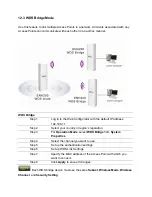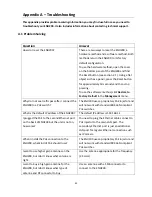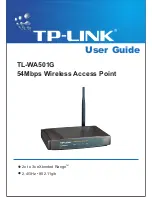
that
have
their
MAC
addresses
added
to
that
network's
MAC
table
can
access
the
network.
Network
Address
Translation
(NAT)
An
Internet
standard
that
lets
a
LAN
use
one
set
of
IP
addresses
for
internal
traffic
and
a
second
set
of
addresses
for
external
traffic.
Network
Time
Protocol
(NTP)
A
protocol
that
lets
devices
synchronize
their
time
with
a
time
server.
NTP
uses
TCP
or
UDP
port
123
by
default.
Passphrase
A
text
string
that
automatically
generates
WEP
keys
on
wireless
client
adapters.
Power
Over
Ethernet
(PoE)
A
PoE
provides
power
to
PoE
‐
enabled
devices
using
an
8
‐
pin
CAT
5
Ethernet
cable,
eliminating
the
need
for
a
power
source.
Preamble
Synchronizes
transmissions
in
a
WLAN.
The
preamble
type
defines
the
length
of
the
Cyclic
Redundancy
Check
block
for
communication
between
a
device
and
roaming
wireless
stations.
Protected
Extensible
Authentication
Protocol
(PEAP)
Authentication
protocol
of
IEEE
802.1x
used
to
send
authentication
data
and
passwords
over
802.11
WLANs.
Quality
of
Service
(QoS)
A
network’s
ability
to
deliver
data
with
minimum
delay.
QoS
also
refers
to
the
networking
methods
used
to
provide
bandwidth
for
real
‐
time
multimedia
applications.
Remote
Authentication
Dial
‐
In
User
Service
(RADIUS)
Networking
protocol
that
provides
centralized
authentication,
authorization,
and
accounting
management
for
computers
to
connect
and
use
a
network
service.
Because
of
its
broad
support
and
ubiquitous
nature,
the
RADIUS
protocol
is
often
used
by
ISPs
and
enterprises
to
manage
access
to
the
Internet
or
internal
networks,
WLANs,
and
integrated
e
‐
services.
Service
Set
Identifier
(SSID)
Name
of
a
WLAN.
All
wireless
devices
on
a
WLAN
must
use
the
same
SSID
to
communicate
with
each
other.
Simple
Network
Management
Protocol
(SNMP)
An
Internet
‐
standard
protocol
for
managing
devices
on
IP
networks.
Snooping
Passively
watching
a
network
for
data,
such
as
passwords,
that
can
be
used
to
benefit
a
hacker.
Temporal
Key
Integrity
Protocol
(TKIP)
An
encryption
protocol
that
uses
128
‐
bit
keys.
Keys
are
dynamically
generated
and
distributed
by
the
authentication
server.
TKIP
regularly
changes
and
rotates
encryption
keys,
with
an
encryption
key
never
being
used
twice.
Transmission
Control
Protocol/Internet
Protocol
(TCP/IP)
A
protocol
that
allows
communications
over
and
between
networks.
TCP/IP
is
the
basis
for
Internet
communications.
Weighted
Fair
Queuing
(WFQ)



































